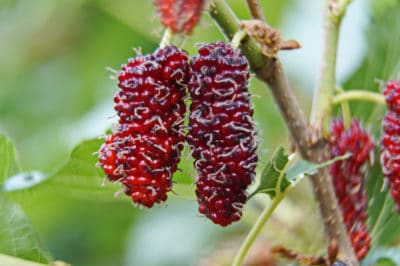General Facts About the Plant.
There are between ten and 16 different species of mulberry trees. The size of the plant can vary widely, from the small black mulberry shrub to the large white mulberry tree which may approach 80 feet in height.
A mulberry plant doesn’t bear fruit for about the first ten years after it’s planted; production of fruit will last for years, however. The black mulberry can live, and be productive, for hundreds of years, while other species will live for 75 years or so.
The mulberry is an aggregate fruit, which means it develops from several plant ovaries, instead of just one. Much like the blackberry or the raspberry, the mulberry is composed of several miniature berries which each contain a seed; these tiny berries, or drupes, join together on a single stem to make the mulberry you pick and eat.
The fruit-bearing of the mulberry may or may not rely on pollination. This plant can produce male and female pollen on its own, or it may be pollinated by bees, butterflies, and other insects who carry the pollens from tree to tree. There are even species of mulberry tree that can grow fruit without being pollinated at all!
Uses for the Fruit, Leaves, and Wood.
Mulberries are sweet and juicy, and contain a good deal of vitamins A, C, E, and K, as well as iron, magnesium, and potassium. Mulberries can be eaten raw or used in many recipes, including:
- Jams
- Pies & Cobbler
- Muffins
- Pancakes
- Sorbet
- Smoothies
The leaves of the mulberry have served many purposes over time. White mulberry leaves were used by the ancient Romans to treat oral, throat, and lung diseases; herbalists today recommend white mulberry leaf tea to aid in the control of blood sugar. Native Americans treated dysentery with mulberry.
The wood of the mulberry tree is quite lightweight and is used in barrels, fencing, and baskets.
Other, Random Facts.
The mulberry’s fruit is commonly thought of as being black or purple, but can also be red, white, or pink. The flower of the mulberry tree is either cream colored or slightly green.
The mulberry is part of the genus Morus, and grows wild in many places but also does well under cultivation. Some gardeners will cultivate a non-fruit-bearing species of mulberry as an ornamental plant.
